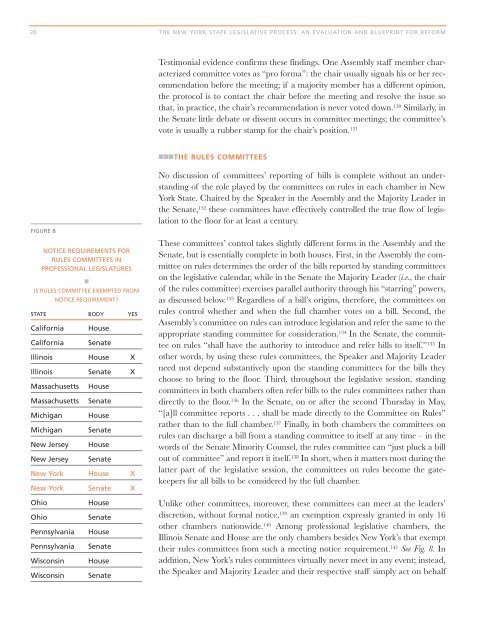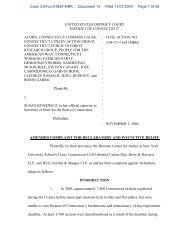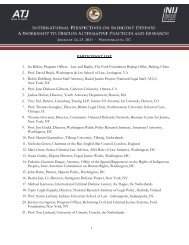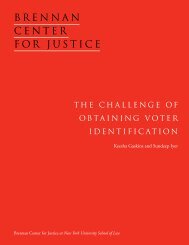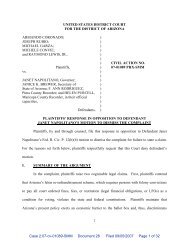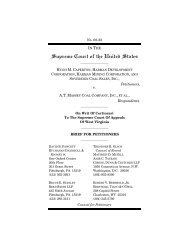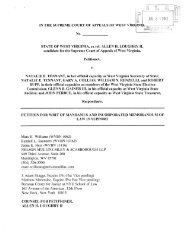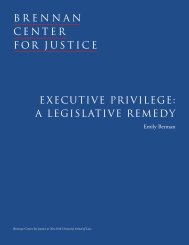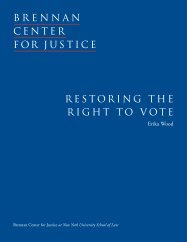THE NEW YORK STATE LEGISLATIVE PROCESS: AN ...
THE NEW YORK STATE LEGISLATIVE PROCESS: AN ...
THE NEW YORK STATE LEGISLATIVE PROCESS: AN ...
Create successful ePaper yourself
Turn your PDF publications into a flip-book with our unique Google optimized e-Paper software.
20 <strong>THE</strong> <strong>NEW</strong> <strong>YORK</strong> <strong>STATE</strong> <strong>LEGISLATIVE</strong> <strong>PROCESS</strong>: <strong>AN</strong> EVALUATION <strong>AN</strong>D BLUEPRINT FOR REFORM<br />
FIGURE 8<br />
NOTICE REQUIREMENTS FOR<br />
RULES COMMITTEES IN<br />
PROFESSIONAL LEGISLATURES<br />
■<br />
IS RULES COMMITTEE EXEMPTED FROM<br />
NOTICE REQUIREMENT?<br />
<strong>STATE</strong> BODY YES<br />
California House<br />
California Senate<br />
Illinois House X<br />
Illinois Senate X<br />
Massachusetts House<br />
Massachusetts Senate<br />
Michigan House<br />
Michigan Senate<br />
New Jersey House<br />
New Jersey Senate<br />
New York House X<br />
New York Senate X<br />
Ohio House<br />
Ohio Senate<br />
Pennsylvania House<br />
Pennsylvania Senate<br />
Wisconsin House<br />
Wisconsin Senate<br />
Testimonial evidence confirms these findings. One Assembly staff member characterized<br />
committee votes as “pro forma”: the chair usually signals his or her recommendation<br />
before the meeting; if a majority member has a different opinion,<br />
the protocol is to contact the chair before the meeting and resolve the issue so<br />
that, in practice, the chair’s recommendation is never voted down. 130 Similarly, in<br />
the Senate little debate or dissent occurs in committee meetings; the committee’s<br />
vote is usually a rubber stamp for the chair’s position. 131<br />
■■■<strong>THE</strong> RULES COMMITTEES<br />
No discussion of committees’ reporting of bills is complete without an understanding<br />
of the role played by the committees on rules in each chamber in New<br />
York State. Chaired by the Speaker in the Assembly and the Majority Leader in<br />
the Senate, 132 these committees have effectively controlled the true flow of legislation<br />
to the floor for at least a century.<br />
These committees’ control takes slightly different forms in the Assembly and the<br />
Senate, but is essentially complete in both houses. First, in the Assembly the committee<br />
on rules determines the order of the bills reported by standing committees<br />
on the legislative calendar, while in the Senate the Majority Leader (i.e., the chair<br />
of the rules committee) exercises parallel authority through his “starring” powers,<br />
as discussed below. 133 Regardless of a bill’s origins, therefore, the committees on<br />
rules control whether and when the full chamber votes on a bill. Second, the<br />
Assembly’s committee on rules can introduce legislation and refer the same to the<br />
appropriate standing committee for consideration. 134 In the Senate, the committee<br />
on rules “shall have the authority to introduce and refer bills to itself.” 135 In<br />
other words, by using these rules committees, the Speaker and Majority Leader<br />
need not depend substantively upon the standing committees for the bills they<br />
choose to bring to the floor. Third, throughout the legislative session, standing<br />
committees in both chambers often refer bills to the rules committees rather than<br />
directly to the floor. 136 In the Senate, on or after the second Thursday in May,<br />
“[a]ll committee reports . . . shall be made directly to the Committee on Rules”<br />
rather than to the full chamber. 137 Finally, in both chambers the committees on<br />
rules can discharge a bill from a standing committee to itself at any time – in the<br />
words of the Senate Minority Counsel, the rules committee can “just pluck a bill<br />
out of committee” and report it itself. 138 In short, when it matters most during the<br />
latter part of the legislative session, the committees on rules become the gatekeepers<br />
for all bills to be considered by the full chamber.<br />
Unlike other committees, moreover, these committees can meet at the leaders’<br />
discretion, without formal notice, 139 an exemption expressly granted in only 16<br />
other chambers nationwide. 140 Among professional legislative chambers, the<br />
Illinois Senate and House are the only chambers besides New York’s that exempt<br />
their rules committees from such a meeting notice requirement. 141 See Fig. 8. In<br />
addition, New York’s rules committees virtually never meet in any event; instead,<br />
the Speaker and Majority Leader and their respective staff simply act on behalf


